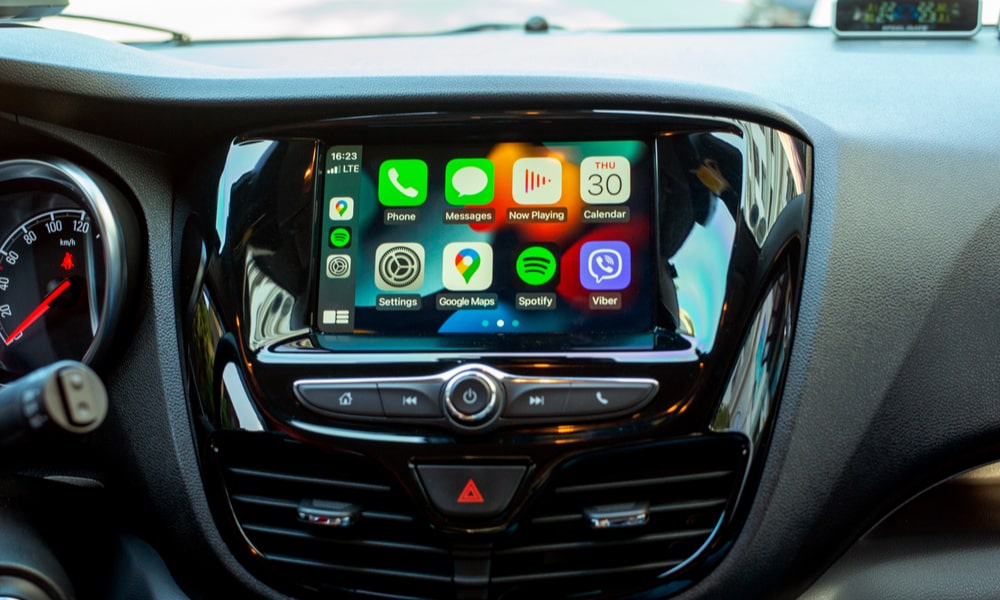‘CarPlay 2.0’ Looks Amazing, But It May Be a Long Time Before We Actually See It
 Credit: NamLong Nguyen / Shutterstock
Credit: NamLong Nguyen / Shutterstock
Toggle Dark Mode
When Apple showed off iOS 16 earlier this week, it spent some time describing some very exciting future enhancements for CarPlay. The company’s executives didn’t talk much about what iOS 16 will bring to CarPlay in vehicles on the road now but rather about the role it hopes to play in the next generation of in-car systems.
Almost all of what Apple showed off on Monday was for what should more appropriately be called CarPlay 2.0. Significantly tighter integration with in-car systems and full multi-display support certainly promises to revolutionize the CarPlay experience, but it will also be years before this becomes mainstream.
After all, consider that Apple debuted Wireless CarPlay in 2016, yet it took five years before it was anything more than a niche feature available on only a handful of models. Since Apple is at the mercy of automakers for this new CarPlay initiative, it will likely experience a similarly slow rollout.
Apple claims to have most carmakers on board with the idea, and the first cars to support “CarPlay 2.0” should be announced in late 2023. However, it’s a safe bet that this will be limited to the usual partners, likely starting with BMW, the first to get wireless CarPlay and Car Key — and by a pretty wide margin.
There are also reports that not every automaker is thrilled with the idea of letting Apple take over their infotainment systems. As lousy as many in-car systems are, some automotive firms can be stubborn; for many, it’s as much a branding issue as the logo on the steering wheel.
The folks at The Verge spoke with several car companies, most of which declined to comment on future initiatives. Those are the kind of responses we’d expect, so it doesn’t suggest that Apple is lying about working with all these partners. Still, a substantial gray area exists between exploring the idea with carmakers and getting a commitment from them.
Of the companies that The Verge spoke with, only BMW, Volvo, and Polestar committed to embracing “CarPlay 2.0.” BMW was the most forthcoming, noting that it “will continue the seamless integration of Apple’s ecosystem,” and evaluate “ how the latest innovations announced at WWDC can be integrated into our solutions.” Volvo and Polestar said they would support the next generation of CarPlay sometime in the future but declined to say when that would happen.
Currently, we have placed a clear focus on further enhancing our iDrive user interface system and, as part of this development, will continue the seamless integration of Apple’s ecosystem. Integral to these efforts will be an evaluation of how the latest innovations announced at WWDC can be integrated into our solutions.BMW spokesperson
Of the rest, only Mercedes-Benz admitted that it was holding discussions with Apple. Still, it was noncommittal beyond saying that’s part of its process to evaluate “all potentially relevant new technologies.” Toyota, Ford, and GM all commented that they had nothing to say, while Volkswagen, Hyundai, Nissan, and Honda didn’t respond.
Apple also isn’t the only game in town when it comes to in-car integration. Google and even Amazon have been ramping up their efforts to get prominent placement on people’s dashboards. Ford’s infotainment systems will ultimately be powered entirely by Android, and Stellantis is working with Amazon for the in-car software for its entire lineup. Meanwhile, although Volvo has said it will embrace the next generation of CarPlay, it’s been much cozier with Google over the years.
Of course, none of this rules out an Apple partnership, and automakers would likely prefer to avoid putting all their eggs in one basket. For example, just because Android is the foundation of an infotainment system doesn’t mean CarPlay can’t run as a service on top of that. It’s just that this playing field is a lot more complicated than it appears at first glance.
Further, we’ve also heard this song from Apple before. While this latest initiative is much bolder, Apple promised us nearly three years ago that it would support multiple screens and heads-up displays in iOS 13.
To be clear, iOS 13 does support these features, even though it seems that Apple would rather forget it ever mentioned it — references to second screens and HUDs have been scrubbed from Apple’s iOS 13 release notes.
The real problem is that most carmakers never embraced these capabilities. They also gave the same sort of non-committal responses to The Verge in 2019 that we’re hearing this week.
This doesn’t mean we won’t see CarPlay 2.0 come to fruition. Apple has promised that at least some cars featuring the new technology will be announced next year, but if you’re hoping this will usher in a new era of improved in-car experiences, I wouldn’t recommend holding your breath.







